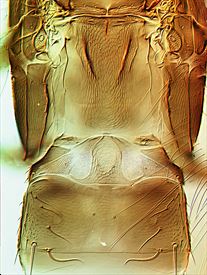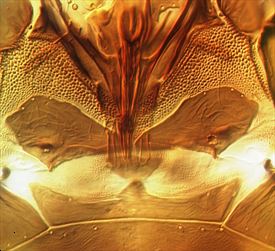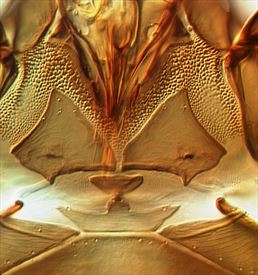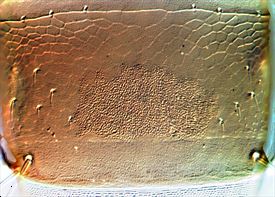
Antenna

Head & pronotum

Metanotum, pelta & tergite II

Female thoracic sternites

Male thoracic sternites

Male sternite VIII pore plate
Distinguishing features
Both sexes fully winged. Female brown; tarsi, distal half of fore tibiae, and apex of middle and hind tibiae yellow; fore wing shaded medially; major setae pale. Head with up to 7 pairs of small, stout cheek setae; maxillary stylets close together, retracted to compound eyes; 2 pairs of postocellar setae; postocular setae short, acute, closer together than in choritus. Pronotum with scattered discal setae; major setae capitate; epimeral setae long, pale; other major setae smaller. Metanotum with sculpture striate medially but more open near posterior and anterior margins; median metanotal setae wide apart, acute; at least 4 pairs of small, scattered setae anterior to these. Prosternal basantra absent; mesopresternum broadly boat-shaped. Fore tarsal tooth variable in size. Fore wings with 9–17 duplicated cilia; sub-basal setae S1 and S2 expanded at apex, S3 longer, acute. Pelta variable, with transverse lateral lobes; tergite IX posteromarginal setae blunt, less than half as long as tube.
Male similar to female, head with cheek setae stouter; pronotum with less sculpture, anteroangular, mid-lateral, and posteroangular setae bluntly acute; metanotum with up to 6 pairs of scattered discal setae; fore wing with sub-basal setae S3 often shorter; sternite VIII with a sub-circular pore plate medially. Large males with pronotum elongate, not sculptured, with stout, median longitudinal apodeme; metanotum reticulate on a raised area; mesopresternum narrowly boat-shaped in contrast to female.
Related species
The genus Hoplandrothrips comprises about 120 species worldwide, particularly in tropical areas, but with nine species recorded from Europe, 16 from Australia, and four from New Zealand. H. vernus is unusual in having the postocular setae acute, very short and not extending to the posterior margin of the compound eyes. H. choritus, H. ingenuus and H. vernus constitute a New Zealand species-group with the following character states different from most other members of Hoplandrothrips: antennal segments dark (not bicoloured); segment III with a straight (not excavate) inner margin; mesopresternum entire (not divided); metanotum with 2 or more pairs of minor setae on anterior half of sclerite, and median major setae arising well behind them; fore femora lacking apical tubercles in male; fore wing scarcely constricted medially, and lacking a median 'pocket'.
Biological data
Fungus feeding on dead wood, mainly in New Zealand native forest.
Distribution data
Known only from New Zealand (ND, AK, CL, BP, TK / SD, NN).
Family name
PHLAEOTHRIPIDAE, PHLAEOTHRIPINAE
Species name
Hoplandrothrips vernus Mound & Walker
Original name and synonyms
Hoplandrothrips vernus Mound & Walker, 1986: 57.
References
Mound LA & Walker AK (1986) Tubulifera (Insecta: Thysanoptera). Fauna of New Zealand 10: 1–140.